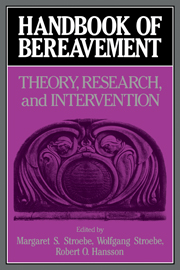Book contents
- Frontmatter
- Contents
- Contributors
- Preface
- Part I Introduction
- Part II The phenomenology and measurement of grief
- Part III Current theories of grief, mourning, and bereavement
- Part IV Physiological changes following bereavement
- Part V The psychological, social, and health impacts of conjugal bereavement
- 12 The mortality of bereavement: A review
- 13 Psychological resilience among widowed men and women: A 10-year follow-up of a national sample
- 14 Determinants of adjustment to bereavement in younger widows and widowers
- 15 The impact of spousal bereavement on older widows and widowers
- 16 The course of spousal bereavement in later life
- 17 Risk factors in bereavement outcome
- Part VI Grief reactions to different types of loss
- Part VII Coping, counseling, and therapy
- Part VIII Conclusions
- References
- Author index
- Subject Index
12 - The mortality of bereavement: A review
Published online by Cambridge University Press: 04 May 2010
- Frontmatter
- Contents
- Contributors
- Preface
- Part I Introduction
- Part II The phenomenology and measurement of grief
- Part III Current theories of grief, mourning, and bereavement
- Part IV Physiological changes following bereavement
- Part V The psychological, social, and health impacts of conjugal bereavement
- 12 The mortality of bereavement: A review
- 13 Psychological resilience among widowed men and women: A 10-year follow-up of a national sample
- 14 Determinants of adjustment to bereavement in younger widows and widowers
- 15 The impact of spousal bereavement on older widows and widowers
- 16 The course of spousal bereavement in later life
- 17 Risk factors in bereavement outcome
- Part VI Grief reactions to different types of loss
- Part VII Coping, counseling, and therapy
- Part VIII Conclusions
- References
- Author index
- Subject Index
Summary
Increasingly in recent years researchers have focused on positive aspects of the experience of bereavement, emphasizing that it is a “growth experience,” that people are “resilient,” and that the illness metaphor should be abandoned in describing the consequences of grief. The chapters in this volume by Silverman and Worden, McCrae and Costa, and Shuchter and Zisook, to name only a few, underline this message. Yet the reason that so much research has focused on bereavement is because the loss of a loved one is associated with extreme mental and physical suffering, not for everyone, and not always lastingly, but for a significant minority. Even more disturbing are the statistics for mortality. Not only do some bereaved individuals fall ill following the loss of a loved one, but they also die.
Given that fatal consequences occur for some bereaved, it is important to identify those who are vulnerable and to understand why they and not others succumb. A decade ago we reviewed the research on mortality (M. Stroebe, Stroebe, Gergen, & Gergen, 1981) and concluded that there was some evidence that bereavement results in excess mortality. However, the surveyed research suffered from many methodological shortcomings. In the meantime, much research has been done and much has been written about the bereavement-mortality relationship. The goals of this chapter, therefore, are to review the scientific evidence that is now available, examine subgroup differences that suggest high-risk categories, and review and evaluate theoretical explanations that could account for the bereavement-mortality relationship.
- Type
- Chapter
- Information
- Handbook of BereavementTheory, Research, and Intervention, pp. 175 - 195Publisher: Cambridge University PressPrint publication year: 1993
- 55
- Cited by

